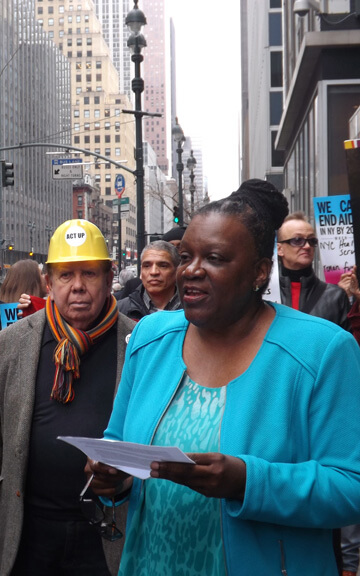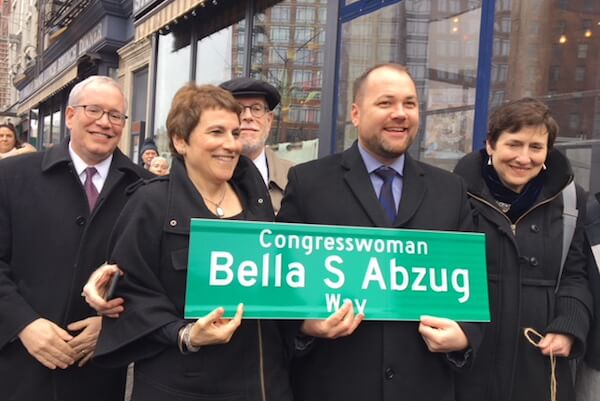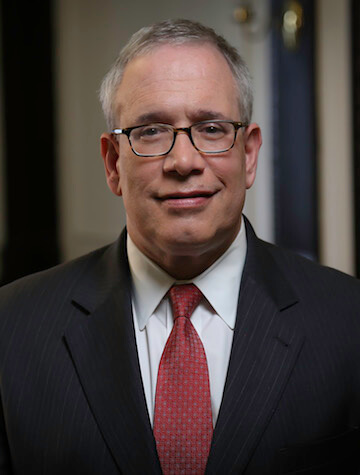Guillermo Chacón, president of the Latino Commission on AIDS, speaks as Housing Works' Jaron Benjamin looks on. | GAY CITY NEWS
Roughly a dozen AIDS services and advocacy groups protested outside Governor Andrew Cuomo’s Midtown Manhattan office demanding that he reverse a change in the state’s proposed budget that would reduce funding for the New York City health clinics that are a core part of the city’s effort to substantially cut new HIV infections by 2020.
“If the Article 6 formula is changed, our ability to end the epidemic will be severely impeded,” said Dr. Margaret Reneau, a senior program analyst at the National Black Leadership Commission on AIDS, an advocacy group, at the February 23 protest.
About 50 people representing the AIDS groups, including Housing Works, Gay Men’s Health Crisis, BOOM!Health, and the Latino Commission on AIDS, marched in front of Cuomo’s office on Third Avenue and heard brief speeches from a half dozen speakers.
Reimbursement formula change could eliminate $11 million a year, with little recourse to federal funding offset
At issue are dollars from Article 6, a portion of state law that reimburses some health spending by cities and towns. New York City’s health department estimated that the proposed change to how the reimbursement is calculated could cost it $32.5 million. Of that amount, AIDS groups have identified $11 million in cuts per year for the next two state fiscal years to programs that contribute to the Plan to End AIDS.
The Plan to End AIDS aims to reduce new HIV infections in the state to 750 by 2020 from estimated new infections in 2014 that could have been as low as 2,100 or as high as 2,800. The great majority of new HIV infections in the state are in New York City. The city hopes to reduce new HIV infections to as low as 600 in 2020.
Cuomo endorsed the plan in 2014, but has consistently balked at funding it. The Cuomo administration has also pushed some costs for major plan components onto the city’s budget, much to the frustration of Mayor Bill de Blasio, who also endorsed the plan in 2014.
The plan uses pre-exposure prophylaxis (PrEP) and post-exposure prophylaxis (PEP), anti-HIV drugs taken by HIV-negative people to keep them uninfected. Both drug regimens are highly effective when used correctly. The plan also treats HIV-positive people with anti-HIV drugs, which keep them healthy and uninfectious. The plan relies as well on services, such as housing and nutrition, for HIV-positive people because such services help them stay on their medication.
Dr. Margaret Reneau of the National Black Leadership Commission on AIDS addresses the crowd, with longtime ACT UP member Andy Velez to the left. | GAY CITY NEWS
While about 80 AIDS advocacy and services groups signed a February 1 letter to Cuomo asking him to reverse the formula change, relatively few principals from those groups turned out for the protest. Notable exceptions were Guillermo Chacón, president of the Latino Commission on AIDS, and Howard Josepher, founder and president of Exponents.
Charles King the chief executive at Housing Works, is credited, along with Mark Harrington, who heads the Treatment Action Group, with conceiving of the Plan to End AIDS. King, who has a long history of aggressive advocacy, is the plan’s leading proponent, but because it relies on the cooperation of the governor and the mayor, he has been unwilling to criticize them publicly.
Andrew Greene, a senior vice president at Housing Works, spoke at the protest, which King did not attend, saying, “We’re here today to protect existing funding.”
When Gay City News asked for a copy of his comments, he handed over a one-page document titled “Talking points for tomorrow” that was written by the Housing Works press office. It read, in part, “Charles underscored that he wants our statement to frame the issue in very measured terms, praising/ thanking the Gov & Mayor for their commitment and urging that the state not inadvertently undermine [the Plan to End AIDS] with this cut.”
The proposed cuts come when any federal funding for HIV prevention or care for HIV-positive people is in the hands of Republicans in Congress – who have already announced plans to alter Medicaid and Medicare, two federal programs that many HIV-positive people rely on – and Donald Trump, the current occupant of the White House and perhaps the most erratic and undisciplined president America has ever had. Trump is surrounded by many agency heads and White House aides who are anti-LGBTQ. It is unlikely that the federal government will replace any state cuts to city funding.
“We are in a moment of uncertainty in terms of federal funding,” Julia DeWalt, the advocacy manager at BOOM!Health, said at the protest. “To assume New York City can access other sources is wrong.”
According to an analysis by Scott Stringer, the city’s comptroller, federal funds accounted for nine percent, or $7 billion, of the city’s $78 billion budget for the 2016 fiscal year, which ended on June 30 of last year. Some city programs rely entirely or almost entirely on federal dollars.
In the city health department, 94 percent of the $194 million HIV prevention and treatment program was paid for with federal cash in the 2016 fiscal year. That program plays a central role in the Plan to End AIDS. In the current fiscal year, 19.2 percent of the city health department’s entire $1.57 billion budget is funded with federal dollars. With a possible battle over federal funding with Congress and the Trump administration before them, the Article 6 dispute has advocates fighting the state to maintain funding.





































